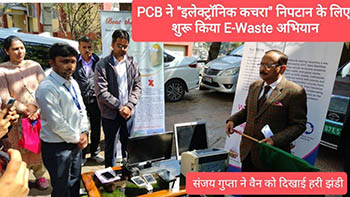Shimla: The Himachal Pradesh government has unveiled an ambitious plan to transform the state into a model of sustainability and environmental responsibility, under the banner of "Green, Clean, and Energy State Himachal".
But rows over the "blue- side of the electric vehicles have erupted across the world as manufacturing of e-vehicles in itself is a polluting process, so is the case with case with disposal of the lithium ion batteries, throwing up a problem of e-waste, and pollution, warn ecologists.
Chief Minister Sukhvinder Singh Sukhu today unveiled a series of initiatives in his Budget presented in the Vidhan Sabha leading the way ahead for "greener future".
These aimed at harnessing renewable energy, promoting eco-friendly transportation, and preserving the natural beauty of the region.
At the forefront of this initiative is the promotion of solar energy, with several large-scale solar power projects set to come online in the near future.
Notably, the largest solar power project with a capacity of 32 MW located at Pekhubella is expected to be commissioned by the end of March 2024.
Aghlor Solar Power Project in Una, boasting an installed capacity of 10 MW, is scheduled for commissioning by June 2024. Furthermore, the Bhanjal Solar Power Project in Una, with a capacity of 5 MW, will be dedicated to the people of the State by September 2024. CM said.
These projects collectively signify the government's commitment to reducing dependence on fossil fuels and mitigating the impact of climate change.
To incentivize the adoption of solar energy among residents, the implementation of the Rajiv Gandhi Start-up Yojana will provide subsidies ranging from 45 percent for the installation of solar panels on owned land.
This initiative aims to bolster the state's renewable energy capacity and encourage sustainable practices among its populace.
In a bid to revolutionize transportation and reduce emissions, the government is aggressively promoting the adoption of electric vehicles (EVs).
Plans to replace 327 diesel buses with electric counterparts is a significant shift towards cleaner and more sustainable mobility solutions.
Furthermore, under the Rajiv Gandhi Swarozgar Start-up Yojana, 10,000 permits will be issued to run e-taxis at a 40 percent subsidy, further incentivizing the transition to electric vehicles, CM said.
However, concerns over the environmental impact of manufacturing lithium-ion batteries, as well as the proper disposal of these batteries, have raised valid concerns among environmentalists and policymakers worldwide.
To address these challenges, the government has announced the establishment of Vehicle Scrapping Facility Centres (VSFCs) under the Vehicle Scraping Policy, aimed at responsibly disposing of old and polluting vehicles.
But its fallout on environment remains yet to be seen and assessed.
Moreover, initiatives such as the Mukhya Mantri Harit Vikas Chhattravriti Yojana and the creation of biodiversity parks highlight a holistic approach to environmental conservation and sustainable development.
The government claims it has streamlined processes for forest clearances and has an action plan for mitigating climate change. to achieve its green objectives.
Much will depend how the government bring these on the ground. As of now, to invest in renewable energy infrastructure, Himachal Pradesh aims to set a precedent for sustainable development practices and win carbon credits.







